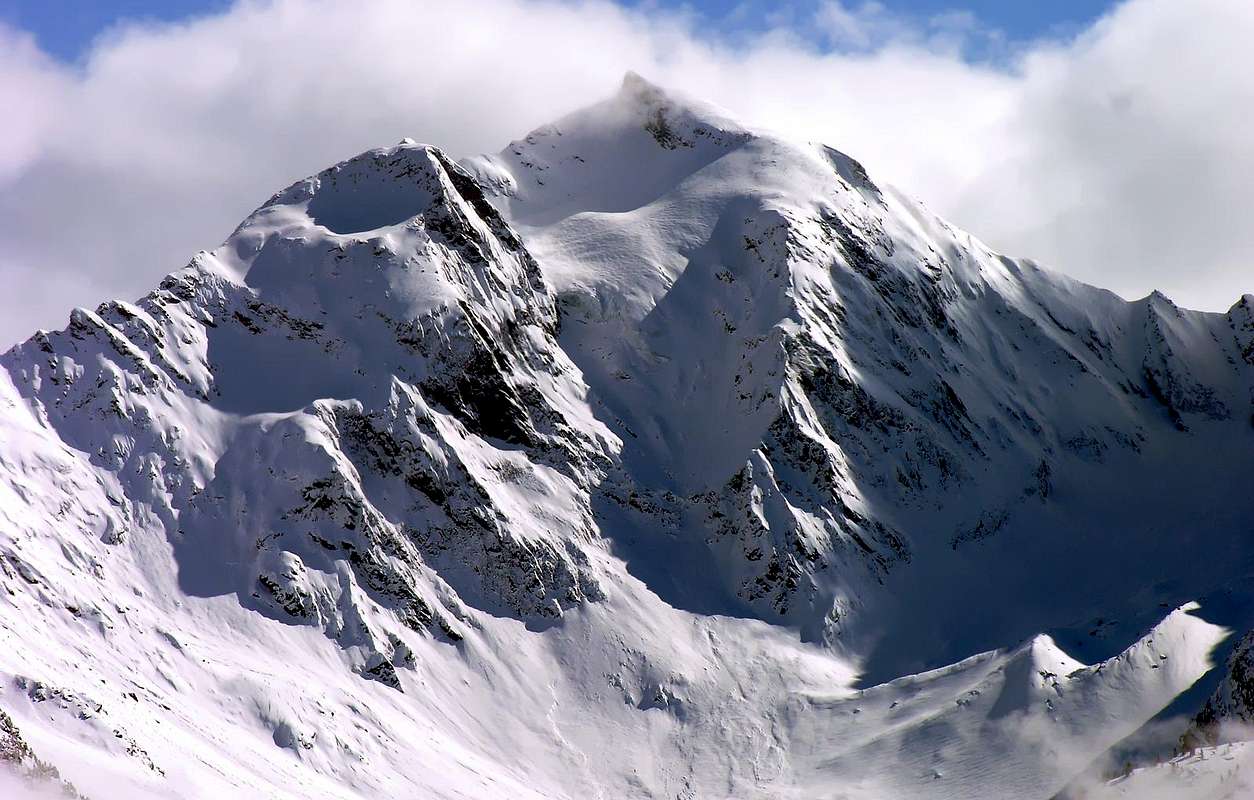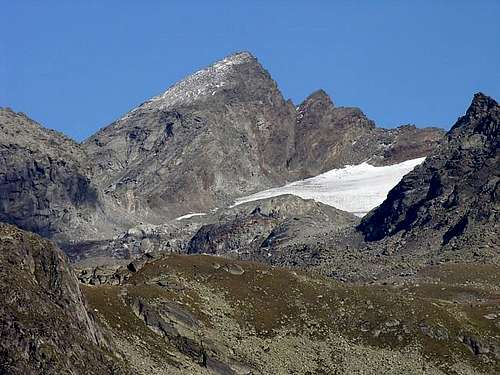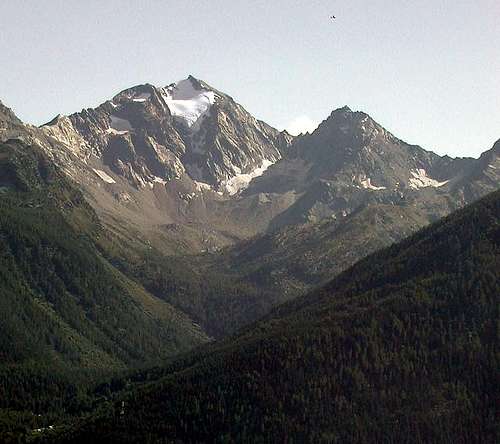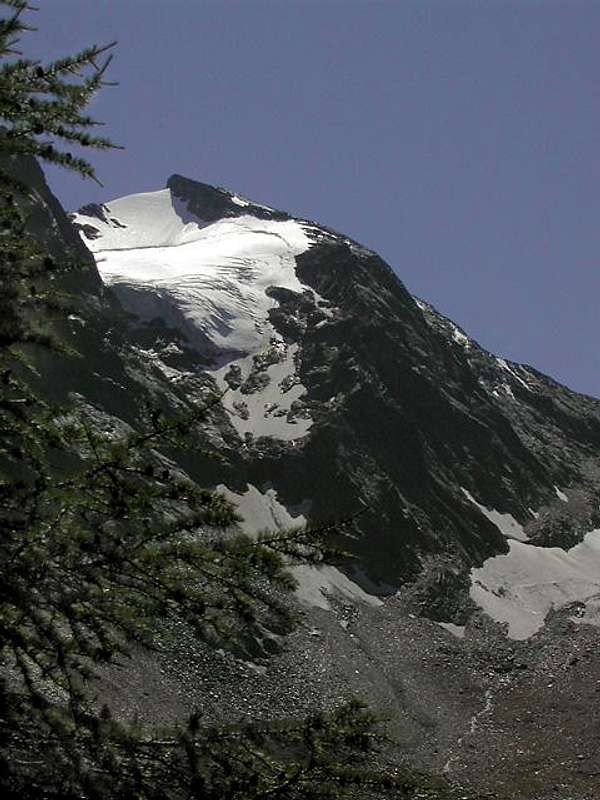-
 17825 Hits
17825 Hits
-
 95.01% Score
95.01% Score
-
 50 Votes
50 Votes
|
|
Mountain/Rock |
|---|---|
|
|
45.67176°N / 7.02868°E |
|
|
Mountaineering |
|
|
10830 ft / 3301 m |
|
|
Overview
Mont Paramont is a slender pyramid that rises from the Northern Slope of Passo di Planaval. It is the furthest ramification of the Rutor Range. The ridge that divides Valgrisenche from the Valley of La Thuile continues from Paramont summit due northeast toward Torre del Tighet, Torre Tonda, Punta di Faveroy and Monte Colombo. In the northwest direction, the same ridge develops into a spur that encloses a wide, short valley with no outlet, which extends to the ice chute of Monte Paramont. The spur splits shortly before Mont Colmet; the eastern branch descends to Colle della Serra and Passo di Ameran, rises again to Becca Pouignenta, and ends at Monte Charvet; the western branch goes through Monte Colmet, Colle della Croce, and the rolling slopes of Testa d'Arpy. The name "Paramont," which means "covering the mountain", perfectly fits this beautiful and unusual peak, perhaps unique in its form: On the northeast ridge, a massive subpeak at 3.154m suggests the crowding together and mingling of two mountains. Between opposing rock bands, the icy and narrow north face rises most elegantly, broken in the middle by a great ice wall that crosses the face almost from side to side. The terminal chute ends just beyond Point 3.154m; as a consequence, it can be seen also from the distant City of Aosta, while the face itself is hardly visible from the valley floor, because it is partially hidden by a lush forest.
Il Monte Paramont (Parete Nord) bella piramide snella che s'innalza dalla costiera Settentrionale del passo di Planaval, costituendo le propaggini estreme della catena del Rutor; dalla sua cima continua verso nord-est in direzione della Torre del Tighet, della Torre Tonda e del Monte Colombo, la cresta divisoria le valli della Valgrisenche e di La Thuile, ma nel contempo origina verso nord-ovest un nuovo contrafforte (a sua volta sdoppiantesi poco prima del mont Colmet e formanti la cresta che, scesa al colle della Serra ed al passo di Ameran, si rialza alla becca Puignenta per morire infine al monte Charvet per il ramo più orientale e la vetta del monte Colmet, il colle della Croce e gli ondulati pendii della Testa d'Arpy per quello occidentale) che forma un valle larga, corta e senza sbocco, terminante ai piedi dello scivolo ghiacciato del monte Paramont. Il toponimo (monte che ripara il monte, ovverosia che lo copre) calza a meraviglia per questa bella, strana e forse unica montagna nelle sue forme; sulla cresta nord-est infatti una massiccia montagna quota 3.154 m dà l'idea dell'accavallarsi di due montagne che si fondono insieme. Fra le due opposte fasce rocciose s'innalza stretta ed elegantissima la parete nord di ghiaccio, fratturata nel centro da un grande muro di ghiaccio che l'attraversa quasi da parte a parte; lo scivolo finale è ammirabile, poiché sbuca proprio oltre la quota 3.154 m, anche dalla città di Aosta, mentre la parete non è individuabile da La Salle sul fondovalle, poiché occultata da una bella foresta.
First Ascent
- First ascent (N-W Arête): Nicodemo Jadanza, (Aug 1880).
- S Arête: Nicodemo Jadanza, (1880).
- N-E Arête: Emanuele Andreis, Luigi Bon and E. Denina, (Aug 03th, 1927).
- Wall N: Pino Formento, Eugenio Bochet and Cesare Quey, (Aug 10th, 1939). * Second: Renato Quendoz and Domenico Chatrian, (Jun 09th, 1968); ** Third: Ilario Antonio Garzotto, Osvaldo Cardellina, Ruggero Busa and Giuseppe "Pino" Trevisan, (Jul 06th, 1969).
- S-W Wall: Osvaldo Cardellina, Roy Cardellina and Danilo Garzotto, (Aug 08th, 1993).
- N-NW Wall: Osvaldo Cardellina, (Jul 27th, 1999).
Getting There
BY CAR:- From Torino, Milano, etc: Motorway A5. Exit in Morgex.
- From Switzerland: through the Grand St. Bernard Tunnel or the homonym Pass.
- From France: through Mont Blanc Tunnel or Petit St. Bernard Pass.
- Aeroporto "Corrado Gex" Saint Christophe (Aosta).
West-northwest Ridge or Normal Route
The North Face
From the City of Aosta (583m) take State Route 26 or Turnpike A5 toward Mont Blanc: from Morgex (923m) head for the small City of La Salle, arrived at Le Pont cross the bridge over the Dora in the direction of the Village of Chabodey, and proceed along the country road that runs through the thick forest toward Alpe Lazei (1.515m). But you must park before, not far from Chabodey, since the country road is open only to residents.Continue in the direction of Montagna della Valle (1.815m) and, on easy mule-track, reach eventually Montagna Alta (1.849m). Here the trail forks: a side spur goes on to Gran Bouillon-more precisely to Alpe Leseney (2.095m). Keep on the main trail along the floor of Vallone di Sopra (d'en Haut) until Montagna di Promou (2.018m). This is a convenient bivy place since the upper valley lacks huts adjacent to the pastures. It's about 3 hours from La Salle to here. The following route description is due to Osvaldo Cardellina and refers to the wall condition in the remote July of 1969. From the pasture continue briefly along the trail, which, after a right turn, ends on the moraine at the foot of the eastern slopes of Chanté Colmet (2.427m). Leave the trail to stay on the valley floor aiming for a small lake (2.123m) in a grassy esplanade strewn with large erratic boulders. Pass the moraine above the lake by just over 200m and proceed straight to the base of the north face. Go up the ice-snow field for about 200m until you are under a rock band, which is roughly 150m tall and abundantly sprinkled by a waterfall. Overcome the cliff on the left, reaching the alternation of snowfields and rock ribs which, after 300m, ends just under the huge serac that divides the face in two. Proceed along the edges of one of the rock ribs (which could serve as shelter in case of icefall) and cross right (west) towards a tiny gully where snowslides are quite common. Climb it quickly, if it is not icy--here the FA party had to cut over 200 steps and use ice pitons--eventually tending toward the orographic right hand side. After about 70m exit to the upper part of the face, which is now significantly less steep. Pass a subsidence and reach the terminal crevasse of the steep final stretch, about 100m high. The crevasse is usually quite open and requires a laborious and delicate crossing. Past this hurdle, aim directly for the summit rock outcrops. (5 hours from Montagna di Promou; 8 hours total). The north face is about 800m tall. In the late sixties the route was rated AD, but the last few hot summers have thinned the great serac and increased the difficulties to D or D+. The danger of avalanches and rock and ice fall has also increased. The slope of the gully alongside the serac is between 50° and 60°.
Gear
Mountaineering equipment including ice axe, helmet, crampons, rope, ice screws, and carabiners.Campings
Remember that free camping is forbidden (except for emergency reasons, over 2.500m, from darkness until dawn).Mountain Condition
- Meteo: you can find all the needed informations at the official site of the Valle d'Aosta Region:
- Valle d'Aosta Meteo
Webcam
- WEBCAM on Aosta Valley:
- Webcam
Books and Maps
BOOKS:- "Guida delle Alpi Occidentali" di Giovanni Bobba e Luigi Vaccarone C.A.I. Sezione di Torino Volume II (parte II) 25-05-1896.
- "Guida della Regione Autonoma Valle d'Aosta" di Mario Aldrovandi, Ed. S.P.E. di Carlo Fanton Torino 1964.
- "80 itinerari di Escursionismo Alpinismo e Sci Alpinismo in Valle d'Aosta", di Osvaldo Cardellina, Ed. Musumeci, Giugno 1977 (in Italian); seconda Ed. Luglio 1981; terza Ed. Luglio 1984; (in French), prima Ed. Febbraio 1978; seconda Ed. Marzo 1980.
- "Guida dei Monti d'Italia Alpi Graie Centrali" di Alessandro Giorgetta - Club Alpino Italiano-Touring Club Italiano, 1985 (in Italian).
- "Ascensioni 1964-1969" Diario Alpinistico di Ilario Antonio Garzotto (unpublished).
- "Diari Alpinistici" di Osvaldo Cardellina e Indice Generale accompagnato da Schedario Relazioni Ascensioni 1964-2019 (unpublished).
- Kompass "Massiccio del Monte Bianco Valle d'Aosta" sentieri e Rifugi Carta turistica 1:50.000.
- Kompass "Gran Paradiso Valle d'Aosta" sentieri e Rifugi Carta turistica 1:50.000.
- L'Escursionista "La Thuile-Piccolo San Bernardo" Carta dei sentieri (n° 2) 1:25.000.
- Enrico Editore Ivrea-Aosta "Gruppo del Gran Paradiso" 1:50.000.
- I.G.M. Istituto Geografico Militare Maps 1:25.000.
Important Information
- REGIONE AUTONOMA VALLE D'AOSTA the official site.
- FONDAZIONE MONTAGNA SICURA Villa Cameron, località Villard de la Palud n° 1 Courmayeur (AO) Tel: 39 0165 897602 - Fax: 39 0165 897647.
- COMPAGNIE DES GUIDES RUTOR Fraz. Entrèves tel/fax 0039.0165.885574 e-mail Guidealpine@lathuile.it
- A.I.NE.VA.(Associazione Interregionale Neve e Valanghe).
Useful Numbers
- Protezione Civile Valdostana località Aeroporto n° 7/A Saint Christophe (Ao) Tel. 0165-238222.
- Bollettino Valanghe Tel. 0165-776300.
- Bollettino Meteo Tel. 0165-44113.
- Unità Operativa di Soccorso Sanitario Tel. 118.


























